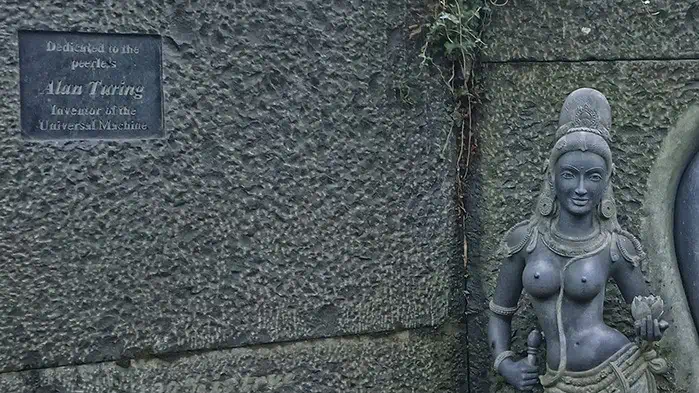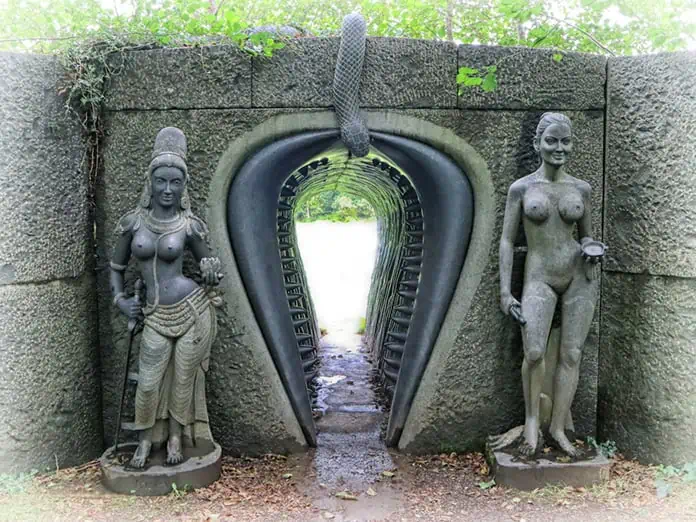
County Wicklow, dubbed “The Garden of Ireland”, is renowned for its National Park, offering visitors the opportunity to see the country’s famed greenery up close on one of its many trails or hikes. Less than an hour from Dublin, its accessibility makes it very popular with tourists who wish to escape the city. Hidden away in the forested land near Roundwood, one of Ireland’s highest villages, there is an unusual phenomenon that escapes the notice of many tourists. This unique collection of Indian sculptures is called Victor’s Way after its designer and founder, Victor Langheld, and it is the only one of its kind in the state. Intended as a contemplation space for adults and described by the owner as a ”mid-life crisis temple”, the park is also a place of inspiration with its non-standard interpretations of deities and phases of human life.
The origins of the park began over 30 years ago in 1989, when Victor sent his designs for a series of sculptures to India, specifically to Mahabalipuram, Tamil Nadu to be modelled by the artist D.V. Murugan and hand-carved by the master sculptor T. Baskaran. This initial process took over 9 years and the first sculpture installed in the park was the Fasting Buddha.
Victor, who was born in Berlin in 1940, spent much of his adult life travelling to spiritual sites in Asia, including walking 67 marathons in Japan as part of studying the path of Zen and becoming a Buddhist monk in India. He spent some of his schooldays in Ireland prior to his India trip and came back there as an adult to sponsor the construction of the sculpture park.
The statues in the park cover a vast range of topics and are influenced by computing principles (it is dedicated to the cryptographer Alan Turing), Eastern religions and Victor’s own life. The unique nature of the park is reflected in its name: when it was first opened, it was called Victor’s Way, emulating Frank Sinatra’s famous line, “I did it my way”.
Following a tantric encounter with a female partner, Victor renamed the park “Victoria’s Way” until 2015, when the park was briefly closed. Victor felt that: “Too may day-trippers came [and] turned it into a fun park for parents with children. It was designed as a contemplative garden for over 28’s.” The name reverted to “Victor’s Way” when it was reopened in 2016 with new age restrictions and a higher entrance fee.
Victor is keen to ensure that the park remains a meditation space for adults between 28 and 60 to allow them quality time for “R&R&R” – rest, recovery and spiritual reorientation – in order to find a way out of the mid-life crisis. Hence the clear message on the website: “Victor’s Way is not suitable for children! It is not!!! [sic] a fun park for families.”

Park entrance with a dedication to Alan Turing
photography by: chripell / Flickr
Spread over 20 acres, the garden has ten major black granite sculptures representing phases of transition in life and 35 minor sculptures made from stone and bronze. The ordering of the statues is carefully chosen so that a walk through the park takes visitors on a complex journey from birth through the trials of adulthood to ultimate enlightenment.
This odyssey begins right at the entrance of the grounds, where the first encounter is with the Birth Canal, a tunnel flanked by two semi-nude ladies and made to represent female genitalia with teeth, known as “vagina dentata” and common at religious sites across Asia. The gate symbolises birth, or more specifically rebirth, with all its inherent mystery and dangers.

Birth Canal
photography by: chripell / Flickr
The channel opens into a field populated by various two to three metre representations of the Hindu god, Ganesh. He is traditionally considered to be the remover of obstacles, an emblem of good luck and the patron of arts and sciences.
The Ganesh grouping is therefore strongly focused on musical instruments, dancing and one is even reading a copy of “Visual Basic”, a computing manual. One particularly interesting feature of the Ganesh statues is the inclusion of small creatures at their bases doing everyday tasks, from Tabla Ganesh’s little buddy casually listening to a Walkman to Uilleann Pipe Ganesh’s diminutive comrade drinking a pint of “Genius”.
The uilleann pipes are an Irish instrument and the variety of Celtic features on this carving have given rise to its nickname of “Paddy Ganesh”. The full group took the sculptors about seven years to complete.
The expanse of the Ganesh field contrasts sharply with the next part of the park, the Enchanted Forest. This is where the sculptures get a little more complex and the light, carefree tone turns somewhat darker.
The first of these is “Awakening”, capturing the moment a child enters the world. Its closed eyes represent its blindness to what lies ahead and it is about to escape the clutches of the claw holding it to emerge into its future life.
Next in line is “Separation”, one of the most elaborate structures in the park. It shows a newborn attempting to nurse from his mother and while one side of the mother is pulling the infant closer, the other side is pushing him away, towards his inevitable independence but resulting in great pain for her.
Moving on, visitors will next come face-to-face with the “Split Human”, a rendering of the mental state of a dysfunctional human at around age thirty. He is being quite literally ripped in two as he struggles to find his goal in life and he is descending into unhappiness and depression as this indecision tears him apart. Victor has said it is meaningful that this man has no genitalia – the lack of phallus reflects the Split Man’s lack of identity and creativity.
The Split Human is closely linked to the “Fasting Buddha”, a very un-Buddha-like statue designed to represent how an adult human’s indecision has continued to eat him up inside until he reaches his lowest point, his dark night of the soul. There are also links between Split Human and “Finger”, a solitary index finger pointing towards the sky and representing the Split Human’s missing phallus. The words “Create or Die”, etched on the fingernail, represent the symbiosis of creativity and identity.
In a green, algae-encrusted pond at the edge of the forest, the “Dying Ferryman” reaches for land that he can never get to, emulating the individual who has lost touch with reality and is waiting to die where he stands, lost in a life lacking meaning and purpose.
After this tableau of tortured spirits, it is quite a relief to emerge from the forest to the lakes, at the centre of which sits Lord Shiva. This Hindi god is the epitome of a soul striving for enlightenment through deep meditation and spiritual help. He recognises the slow decline of life and is driven to live it to the fullest, leaving his troubled past behind and moving forward with reflection and clarity.
This theme is continued in “Nirvana Human”, who has achieved self-realisation and the happiness that comes with this. The statue exudes inner peace and a deep sense of contentment at having finally achieved the one true goal in life. Other sculptures of note in the park are a semi-nude representation of a wise and loving Eve and a large python-shaped seat known as the “Wisdom Seat”.
The combined effect of examining all of these chiselled characters is to expand the normal state of consciousness and move into a quiet place of contemplation, open to interpreting the world in a more considered manner. They are designed to appeal to people at the difficult stages of middle life and to delve into the human unexplored potential for growth through creativity.
While the sculptures are the main feature of the park, it has some additional intriguing attractions. One of these is the “philosophy maze”, a series of contemplative messages on wooden signposts, though this has now largely fallen into disrepair.
Another popular part of the gardens are wooden recliners designed for “forest bathing”. This means lying back amongst the trees and becoming immersed in the holistic ambiance of the forest. The idea is to use the natural surroundings to regenerate the mind, body, and spirit.
The recliners and the benches are in place to encourage visitors to take their time and fully appreciate the serenity of the forest, allowing them to contemplate life and creativity. While the park doesn’t have specific rules, the website requests that “chatty companions, children and dogs” should not be brought and mobile phones are strongly discouraged apart from to take photos.
Slow solo walking is encouraged and the 2km path is intended to take 1.5 to 2 hours to get around. Irish weather being notoriously changeable, even in summer, means that appropriate outdoor clothing should be worn to ensure the climate doesn’t take away from the introspective experience.
From Dublin airport, Victor’s Way is less than an hour’s drive via the N11 southbound. Follow signs for Kilmacanogue towards Glendalough (R755) and after about 11km turn right towards the Sally Gap (R759). The sculpture park is in Mullinaveige, in the direction of Roundwood, on the L1036. It is seasonal, opening from mid-April to mid-October from 12pm to 6pm with an entrance fee of €10 per adult. Victor himself is usually there to greet customers but if not, there is an Honesty Box at the entrance where you can pay in.